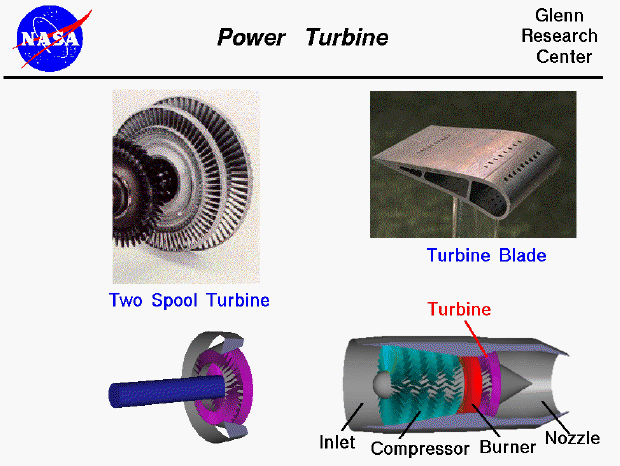

An animated version of this slide is also available. The image is larger than this page (250K) and may take longer to download.
Most modern passenger and military aircraft are powered by gas turbine engines, which are also called jet engines. There are several different types of gas turbine engines, but all turbine engines have some parts in common. All gas turbine engines have a power turbine located downstream of the burner to extract energy from the hot flow and turn the compressor. Work is done on the power turbine by the flow; the mathematical details of this process are given on a separate slide.
Description of Images
The bottom of the figure shows:
In both drawings, the turbine is magenta in color. The front (left end) of this shaft would be attached to the compressor, which is colored cyan in the drawing.
The upper left of the figure shows an actual power turbine. The turbine, like the compressor, is composed of several rows of airfoil cascades. Some of the rows, called rotors, are connected to the central shaft and rotate at high speed. Other rows, called stators, are fixed and do not rotate. The job of the stators is to keep the flow from spiraling around the axis by bringing the flow back parallel to the axis.
Depending on the engine type, there may be multiple turbine stages present in the engine. Turbofan and turboprop engines usually employ a separate turbine and shaft to power the fan and gear box respectively. Such an arrangement is termed a two spool engine. For some high performance engines, an additional turbine and shaft can be present to power separate parts of the compressor. This arrangement produces a three spool engine. The power turbine shown on the upper left of the figure is for a two spool, turbofan engine.
Design Details
There are several interesting turbine design details present on this slide. Since the turbine extracts energy from the flow, the pressure drops across the turbine. This pressure gradient helps keep the flow attached to the turbine blades. So the pressure drop across a single turbine stage can be much greater than the pressure increase across a corresponding compressor stage. A single turbine stage can be used to drive multiple compressor stages. To keep flow from leaking around the edges of the turbine blades, because of the higher pressure gradient, the tips of the turbine blades may be banded together.
The turbine blades exist in a much more hostile environment than compressor blades. Sitting just downstream of the burner, the blades experience flow temperatures of more than a thousand degrees Fahrenheit. Turbine blades must, therefore, be made of special materials (http://www.ueet.nasa.gov/parts.html). that can withstand the heat. Or they must be actively cooled. At the upper right of the figure, we show a picture of a single, actively cooled turbine blade. The blade is hollow. And cool air, which is bled off the compressor, is pumped through the blade and out through the small holes on the surface to keep the surface cool.
Go to...
byTom
Benson
Please send suggestions/corrections to: benson@grc.nasa.gov